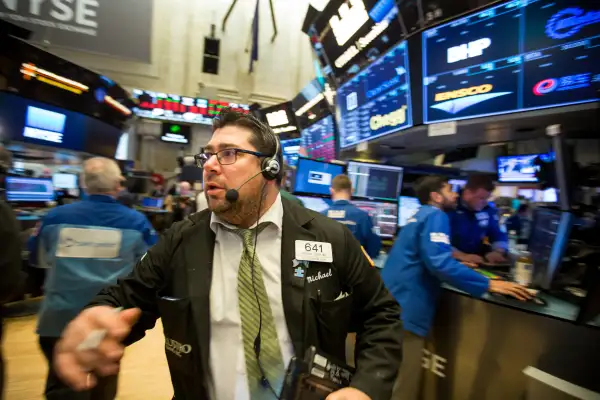The Stock Market Is Now in a 'Pullback.' Here's What You Should Do
Money is not a client of any investment adviser featured on this page. The information provided on this page is for educational purposes only and is not intended as investment advice. Money does not offer advisory services.

A stock market slide that has already erased more than 2000 points from the Dow Jones Industrial continued Tuesday, with the Dow falling another 560 points at the market open.
By the end of the trading day, the Dow had swung all the way back and more — up more than 560 points.
But the speed at which the market has bounced up and down has left many investors spooked, especially those who have been lulled by a nearly nine-year-old bull market.
"Market corrections are normal, no matter how nerve-wracking they are at the time," says Greg McBride, chief financial analyst for Bankrate.com. He adds that investors should "maintain a long-term perspective and resist the urge for any knee-jerk reactions," noting that the market is about where it was a mere two months ago.
In fact, financial strategists say there are several reasons for worried investors to do one thing: calm down.
Reason #1: This is not a bear market yet.
At the worst point of this sell-off on Tuesday morning, the Dow was down more than 2,800 from the market's peak on Jan. 26.
That represents a 10.7% decline. That's well short of an official "bear market," which is defined as a market drop of 20% or more. But because stocks fell more than 10%, this may be considered a "correction."
Well, sort of. Typically, market watchers rely on the S&P 500 index to gauge the health of the broad U.S. market instead of the 30 stocks in the Dow.
And the S&P 500 has fallen only 9.7% so far in this slide, which means this is technically just a "pullback," defined as a loss of 5% to 9.9%. (There's no technical definition of "crash," which is often used to describe a big, fast-moving downturn.)
Why does this matter? Because pullbacks and corrections are actually extremely common on Wall Street. Since the end of 1945, there have been 57 pullbacks (or about one every 1.3 years) and 21 corrections.
Sam Stovall, chief investment strategist at the research firm CFRA, crunched the numbers and found that it has historically taken just two months for the markets to recover from the typical pullback and four months from the average correction.
By comparison, it usually takes stocks more than two years to bounce back from bear market and nearly six years to recoup all the losses from a "mega bear," like the 2007-2009 downturn amid the financial crisis and the 2000-2002 tech wreck.
Before undoing your entire strategy, investors "need to realize the speed with which markets get back to break even following pullbacks and corrections," Stovall says. If you're a long-term investor and this remains no worse than a correction, "you don't lose if you don't sell."
Reason #2: History says this is not likely to become a bear.
On the one hand, you could argue that the stock market is long overdue for a bear. The rally that began in March 2009 is about to celebrate its ninth birthday, which makes it the second oldest bull market in history.
However, history says bear markets typically signal the onset of a recession—which doesn't appear to be on the horizon right now.
"Bear markets are almost always caused by a decline in the real economy. That’s because it takes a recession to simultaneously damage both the valuations multiples and earnings growth of businesses, says Paul Eitelman, a strategist at Russell Investments. Right now, "this does not look like a recession scare to us."
In fact, it's just the opposite. Investors are scared the economy may be accelerating too quickly, as wage growth is hinting at inflationary pressures, which are driving up interest rates, which in turn are spooking investors.
The yield on 10-year Treasuries, for instance, climbed to a four-year high of 2.86% earlier this week — which is a sign of economic strength, not weakness.
Reason #3: Even if this turns into a bear, it may not be severe.
Okay, not every bear market precedes a recession. There have been a handful of occasions when the market plunged 20% or more without the economy going into reverse.
However, history shows that those rare occurences tend to be associated with shallow bear markets in which investors recover their losses relatively quickly.
Take 1987. While the Black Monday crash that erased nearly a quarter of the stock market's value in a single day strikes fear into the hearts of most investors, the '87 bear market itself lasted only three months. By comparison, the typical bear unfolds over nearly a year and a half.
And after the selling was over, it took a shorter-than-average 20 months for the stock market to recoup all its losses.
Similarly, the bear market that began in 1966 was also short in duration — it lasted only eight months. What's more, it only took 7 months thereafter for the market to break even, versus 56 months for the tech wreck.
Reason #4: The economy itself remains strong
"The violence in the move and the spike in volatility is unsettling, but the market fundamentals remain healthy," says Mark Hackett, chief of investment research at Nationwide.
For example, "corporate earnings to continue to see healthy growth in the months ahead, given current, solid economic data and new corporate tax cuts," said Patric Chovanec, chief strategist at Silvercrest Asset Management. "This means share prices should rise, as long as valuations hold."
What's more, economic indicators show that manufacturing economy remains strong. The J.P.Morgan Global Manufacturing index, for instance, is hovering near an 82-month high.
Plus, real economic growth in the U.S. has grown at an annual rate faster than 3% for three straight quarters — something not seen since before the Great Recession.
That's hardly bad news for stocks.
